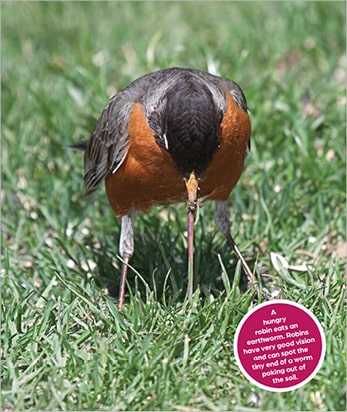The Life Cycle of an Earthworm Blog Post
STEAM Activities: Poetry Inspired by Nature
By Lisa Owens
The first thing I do when preparing to write nonfiction books like The Life Cycle of an Earthworm is study the topic, and I love finding facts that surprise me. One example from this book’s research is discovering that the giant South African earthworm can reach a length of 22 feet. That struck me as awfully big!
It’s cool, though, to picture a 22-foot earthworm wriggling around, minding its business, living its life. I can easily imagine creating a poem, story, song, or other artwork inspired by the creature. And I’ve consistently found that anytime a factual detail catches a young reader’s attention — whether it’s funny, cute, icky, scary, or just hard to comprehend — creative expression of that interest tends to bubble up.
In this six-post series for The Child’s World, I’m sharing a few insights into the writing of my Life Cycle titles and offering related STEM and STEAM extension activities for classroom use. This time I’ve focused on using nature-inspired poetry to encourage students’ natural curiosity and their drive to channel that curiosity through creativity.
Discussion: Recognizing the Truth in Humor

After the class has read The Life Cycle of an Earthworm, turn to page 21 and show the photo of a robin picking up an earthworm. Ask students what the scene illustrates. (Birds prey upon earthworms, birds hunt worms during the day, the robin is eating breakfast.)
Next, as a read-aloud or via this linked recording, share Shel Silverstein’s “Early Bird” poem from Where the Sidewalk Ends.
Confirm that Silverstein meant the poem to be humorous, and then reread or replay it, emphasizing the last line, “But if you’re a worm, sleep late.”
Mention that it’s often said there’s a bit of truth in every joke. Then have volunteers list any truths they notice in this humorous poem. (Birds get up early, birds eat worms, earthworms are hunted by other animals.) If appropriate, ask students why they think it’s considered funny to say worms should sleep late. (Birds won’t find them, birds won’t eat them, we’re rooting for the earthworm, the joke is unexpected, it makes it easier to discuss realities of life/the life cycle.)
Writing Corner: Creating Earthworm Poetry
Following the discussion, plan a low-stress poetry-writing session for later the same day or the day after. Explain that students will write original poems on the simple open-ended theme of earthworms. Then brainstorm a “favorites” list of earthworm traits, behaviors, and life-cycle facts. Assure students that the list will remain on display as they write.
To kick off the official writing session, have students first jot down pre-writing thoughts about their poems using these, or your own, targeted prompts:
- My poem is about _. (earthworms, nature)
- I want my poem to be _. (funny, sad, silly, realistic, scary, icky)
- My poetry form is _. (rhyming, free verse, acrostic, bio poem, limerick, haiku)
Next, start the clock on the writing session. Use whatever length of time works best for your class. Afterward, invite your young poets to share and celebrate their creations with the group.
About the Book
The Life Cycle of an Earthworm (The Child’s World, 2023) details the animal’s unique journey from eggs to juvenile earthworm to the adult stage, during which the life cycle begins anew. Striking full-color photographs support the text, and carefully constructed front and back matter increase comprehension.
Lisa L. Owens has written more than 100 books for young readers. Find her online: website, X (formerly known as Twitter), and Instagram.
